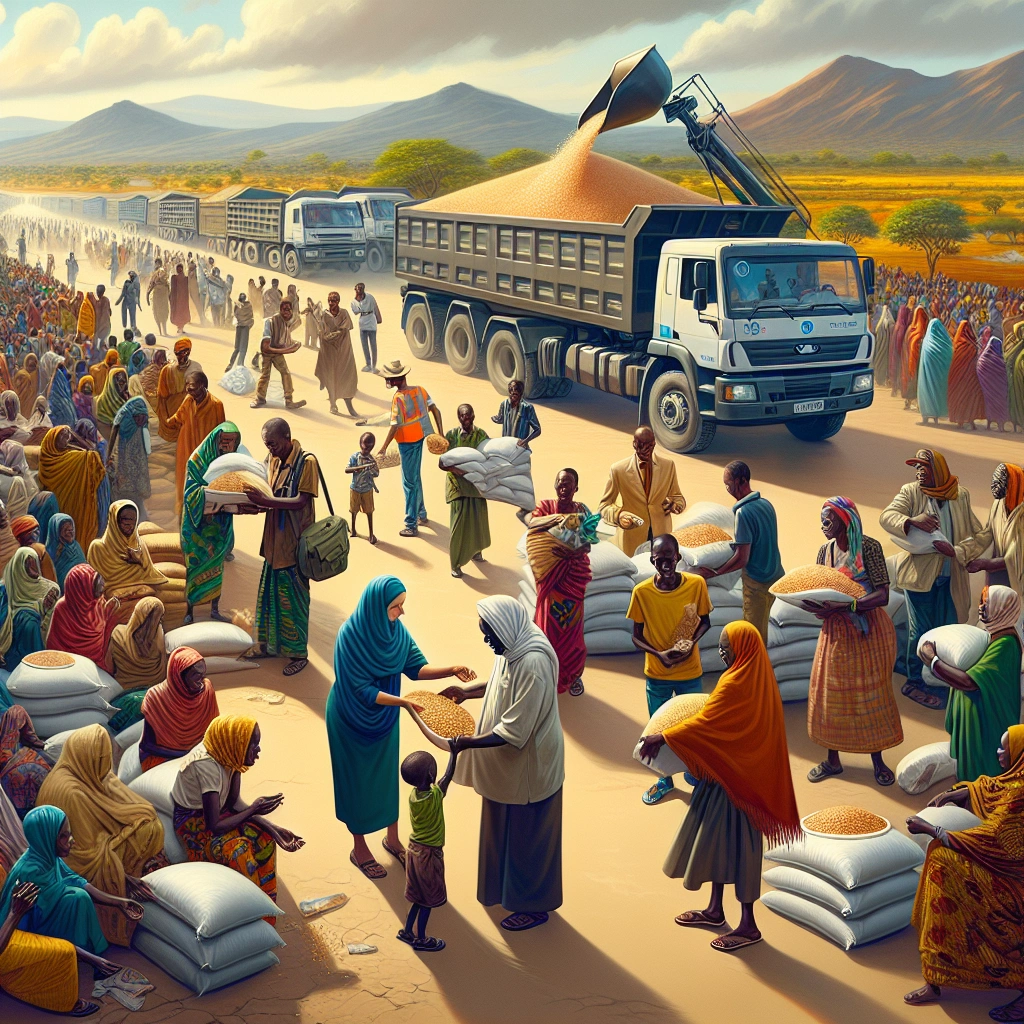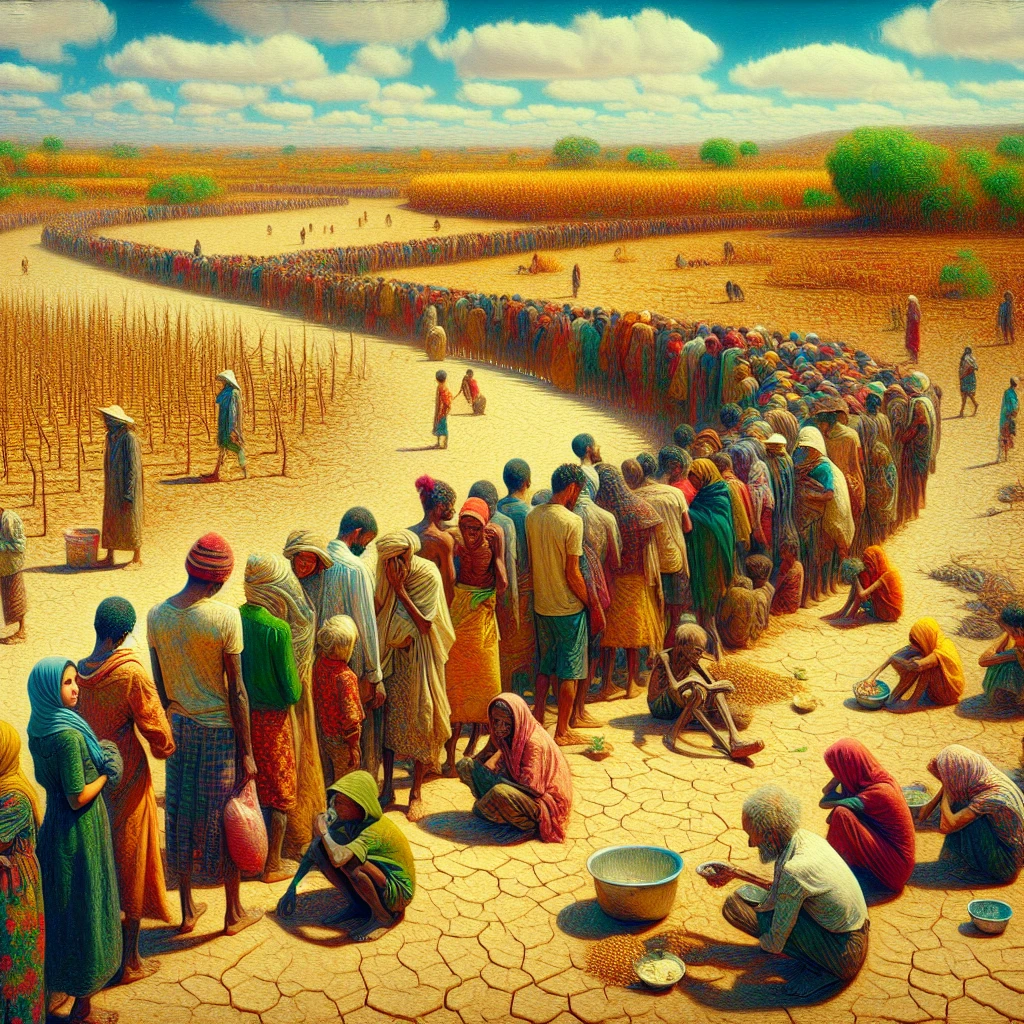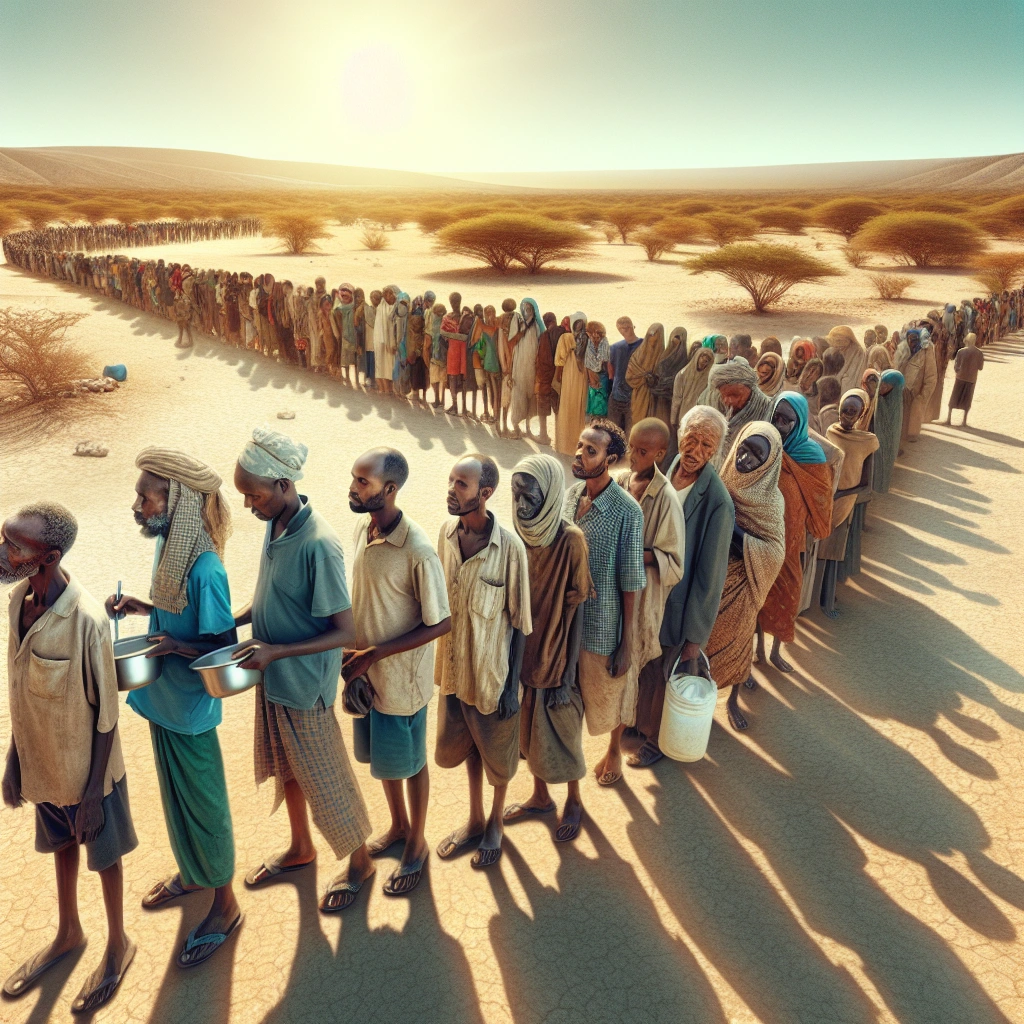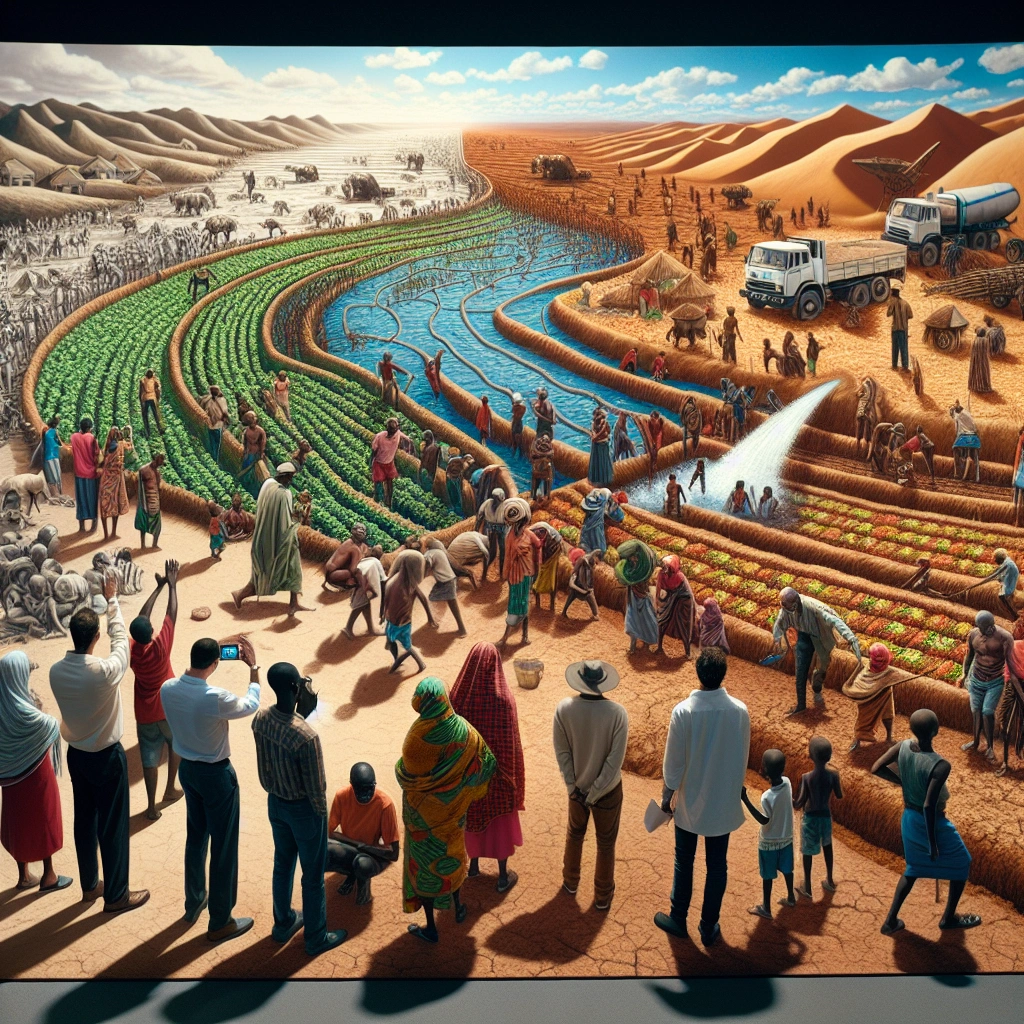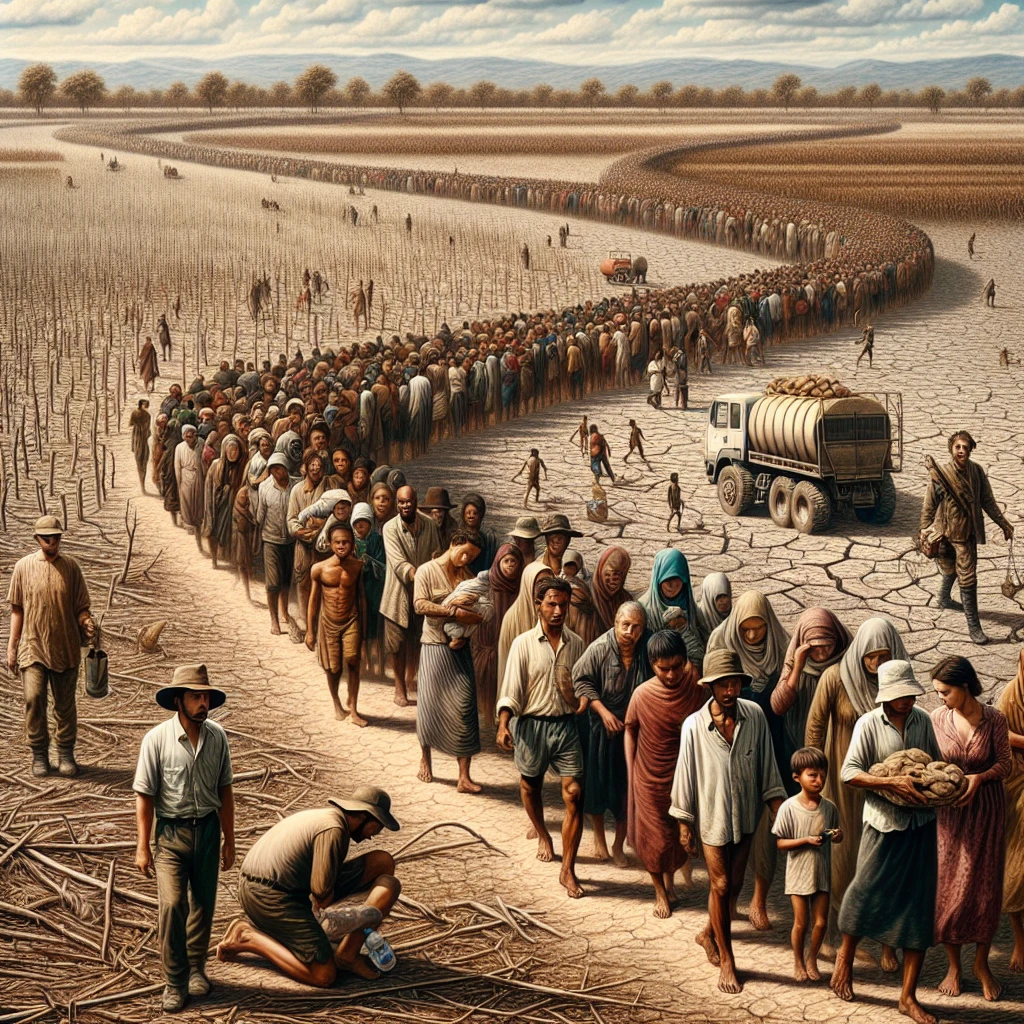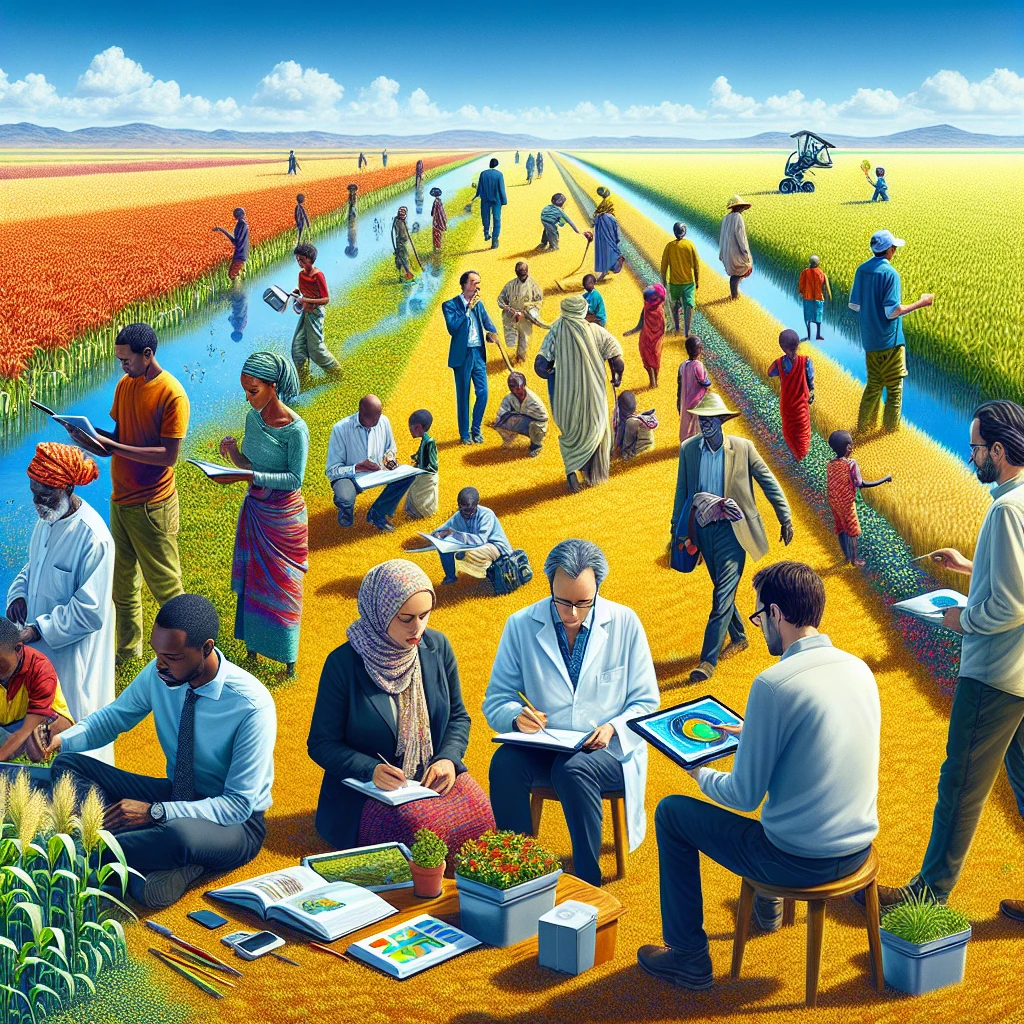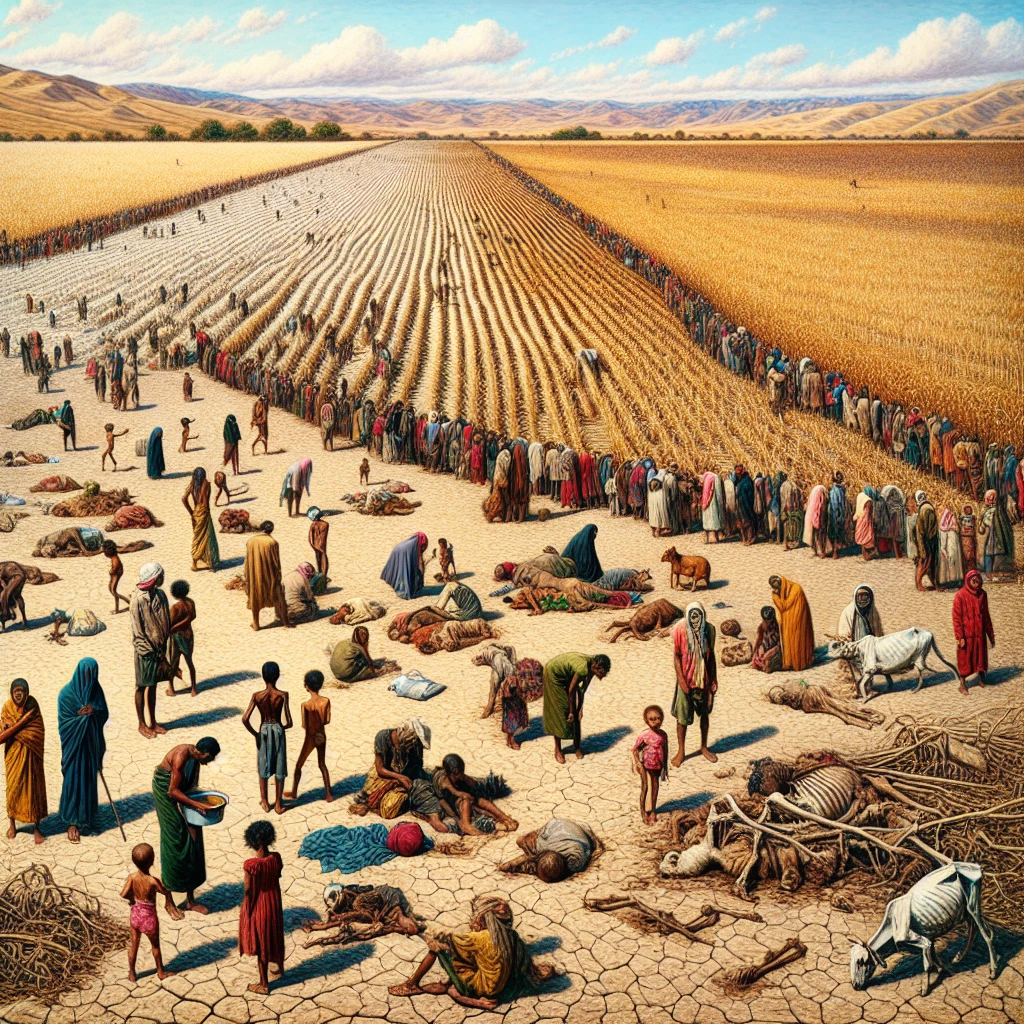

Food shortage is the lack of a consistent and adequate supply of food in a region or country. Understanding food shortage statistics in the Horn of Africa is important for assessing the severity of the situation and determining the appropriate response.
The current situation in the Horn of Africa countries is dire, with millions of people facing acute hunger due to prolonged drought and other contributing factors.
Curious about the current food shortage statistics in the Horn of Africa countries? Check out this Youtube video:
The Causes of Food Shortage in the Horn of Africa
Climate change and its impact on agriculture
Due to rising temperatures, the Horn of Africa has experienced significant water evaporation from plants and soils, resulting in crop losses, water shortages, and livestock deaths. Climatic changes have made agricultural development in Africa more challenging, leading to less favorable weather patterns and increased volatility of crop and livestock yields.
This has exacerbated droughts, deepening hunger and contributing to food insecurity in the region.
Conflict and political instability
Armed conflicts, communal violence, and other localized tensions have disrupted peace and security in the Horn of Africa, driving 8.5 million people into acute food insecurity. Ongoing conflict and political instability have contributed to soaring food prices, further exacerbating hunger and food insecurity in the region.
Economic challenges and poverty
Economic challenges, poverty, and rural-urban migration have led to widespread unemployment and a breakdown in traditional coping mechanisms, contributing to food insecurity. In addition, lack of resilience to climatic events has made food supplies and prices especially vulnerable in sub-Saharan Africa, further perpetuating the cycle of poverty and hunger.
| Factor | Impact |
|---|---|
| Climate Change | Water evaporation, crop losses, and livestock deaths have deepened hunger and exacerbated food insecurity. |
| Conflict and Instability | Localized tensions, armed conflicts, and political instability have disrupted peace and driven millions into acute food insecurity. |
| Economic Challenges | Poverty, unemployment, and lack of resilience to climatic events have made food supplies and prices vulnerable, perpetuating food insecurity. |
Impact of Food Shortage on the Population
Hunger and malnutrition
Hunger and malnutrition resulting from food shortage lead to severe consequences such as stunted growth, weakened immune systems, and impaired cognitive development in children. This can perpetuate a cycle of poverty and hinder their ability to thrive in the future.
Health implications
The health implications of food shortage are far-reaching, leading to an increased risk of chronic diseases such as diabetes, obesity, and heart disease. Additionally, malnutrition and food insecurity contribute to mental health disorders and can have long-lasting effects on individuals, particularly children and adolescents.
Social and economic consequences
The social and economic consequences of food shortage include decreased productivity, hindered learning capabilities, and adverse effects on mental well-being. Moreover, food insecurity has been linked to low wages, adverse social and economic conditions, and limited access to healthy foods, further perpetuating the cycle of poverty.
Government and NGO Interventions
Aid and relief efforts
Aid Organizations: International aid organizations like the Canadian Humanitarian Assistance Fund (CHAF) play a crucial role in providing relief efforts during food shortages. For example, CHAF responds to smaller-scale, rapid-onset crises, ensuring unmet humanitarian needs are addressed promptly.
NGOs: On the other hand, non-governmental organizations (NGOs) such as the United States’ Bureau of Population, Refugees, and Migration have been instrumental in providing critical aid and relief efforts. These organizations primarily focus on aiding individuals suffering from conflict, famines, and natural disasters, contributing significantly to alleviating food shortages.
Financial Contribution: The United States alone contributed nearly $13 billion in fiscal year 2021 towards humanitarian assistance worldwide, stressing the importance and impact of aid and relief efforts in addressing food shortages.
| Humanitarian Organizations | Relief Efforts |
|---|---|
| Canadian Humanitarian Assistance Fund (CHAF) | Responds to smaller-scale, rapid-onset crises |
| NGOs | Aids victims of armed conflict, famines, and natural disasters |
| United States | Contributed nearly $13 billion towards humanitarian assistance worldwide in fiscal year 2021 |
Sustainable development initiatives
The Sustainable Development Agenda: Sustainable Development Goals (SDGs) act as a compass for aligning nations’ plans with global commitments, aiming to foster sustainable development initiatives in the Horn of Africa countries.
Non-Governmental Organizations (NGOs): NGOs also play a pivotal role in sustainable development efforts across the globe, with their country-led initiatives and drive for sustainable development partnership revitalize.
Civil Society Engagement: Civil society partnerships, particularly within the framework of international assistance policies, contribute to deeper understandings of global issues while promoting and mobilizing efforts towards sustainable development.
Policy and advocacy efforts
Role of NGOs: NGOs significantly engage in the protection of human rights, employing various strategies at different levels to advocate for policies focused on addressing food shortages and humanitarian crises.
Policy Advocacy: NGO-led policy advocacy aims to leverage the passion of citizen activists and association members to advance public policy goals, bridging gaps where governments often neglect dire situations such as food shortages.
Partnerships: In the United States, approximately 1.5 million NGOs undertake a wide array of activities, including political advocacy on issues such as foreign policy, elections, and economic development.
The efforts of governments and NGOs play a vital role in addressing the food shortage statistics in the Horn of Africa countries through aid and relief, sustainable development initiatives, and policy advocacy.
Note: The above information is based on publicly available data and serves to highlight the essential interventions of government and NGOs in addressing food shortage statistics in the Horn of Africa countries.
Access to Food and Distribution Challenges
Infrastructure Limitations
Food distribution in the Horn of Africa countries faces significant challenges due to the inadequate infrastructure, hindering the efficient movement of food from production centers to distribution points. For example, poor road networks and lack of proper storage facilities contribute to significant food losses during transportation and storage.
Market Dynamics and Supply Chain Issues
The market dynamics in the Horn of Africa countries add to the food shortage statistics, with unpredictable demand patterns and seasonal fluctuations exacerbating supply chain issues. For instance, the inability to accurately predict market demands leads to surplus or shortage of food, impacting the overall distribution of resources.
Role of International Partnerships
International partnerships play a crucial role in addressing food shortage statistics in the Horn of Africa countries by providing technical and financial assistance to improve infrastructure, develop efficient supply chain solutions, and mitigate market dynamics. For instance, collaborations with international organizations and governments can lead to the implementation of sustainable and resilient food distribution systems.
Current Food Shortage Statistics in Ethiopia
Overview of food shortage situation
In Ethiopia, the food shortage situation is dire, with approximately 22.8 million people lacking sufficient food for consumption as of May 2023. The prevalence of food insecurity in Ethiopia is staggering, affecting 22.25 percent of the population. With the severity of food insecurity being among the worst globally, the country is facing acute challenges related to hunger and malnutrition.
Statistical data on malnutrition and hunger
Statistical data paints a grim picture of malnutrition and hunger in Ethiopia. According to the Global Hunger Index, Ethiopia’s state of chronic food insecurity and malnutrition is categorized as serious, ranking 90th out of 116 countries with sufficient data to calculate GHI scores.
In addition, the Prevalence of undernourishment stands at a concerning level, with a significant portion of the population experiencing moderate or severe food insecurity.
Government and international response
In response to the crisis, the Government of Ethiopia and international organizations are taking action to address the food shortage. The World Food Programme (WFP) has been targeting over 3.3 million people across different regions in Ethiopia, providing unconditional emergency food and nutrition assistance.
Additionally, through the Government of Ethiopia’s Productive Safety Net Programme, chronically food-insecure households receive vital food and cash transfers during critical times. Despite the challenges, efforts are being made to mitigate the impact of the food shortage on millions of people in Ethiopia.
| Organization | Population Targeted | Assistance Provided |
|---|---|---|
| World Food Programme (WFP) | Over 3.3 million | Emergency food and nutrition assistance |
| Government of Ethiopia | Chronically food-insecure households | Food and cash transfers during critical times |
The severity of the situation calls for collaborative efforts on both national and international levels to ensure that the population’s basic food and nutrition needs are met.
This is just part of a whole blog.
Current Food Shortage Statistics in Somalia
Overview of food shortage situation
The food shortage situation in Somalia is alarming, with approximately 6.6 million people expected to experience high levels of acute food insecurity between April and June 2023. This crisis has particularly hit hard in rural areas, leaving millions of Somalis struggling to access basic nutritious food.
Statistical data on malnutrition and hunger
Statistical data reveals the severity of malnutrition and hunger, with an estimated 7.8 million people facing severe food shortages in Somalia/Somaliland. Additionally, around 1.8 million children are at risk of acute malnutrition, including 330,630 who are likely to be severely malnourished.
The prevalence of undernourishment in the country is at a staggering 59.5%, the highest of any country with available data.
Government and international response
In response to the crisis, international organizations and governments, including the United States Agency for International Development (USAID) and the World Food Programme (WFP), have been providing vital support. USAID continues to offer emergency food, health, nutrition, protection, shelter, and WASH assistance, as well as programs aimed at building community resilience.
Meanwhile, WFP has been delivering life-saving food assistance through in-kind rations or cash, enabling recipients to have more choice and creating new markets for local producers and retailers.
Current Food Shortage Statistics in Eritrea
Overview of food shortage situation
Eritrea is currently experiencing a dire food shortage situation, exacerbated by harsh climatic conditions including cyclical droughts and heavy rains leading to flooding. The country has been further challenged by desert locust infestations and a transportation ban due to COVID-19. These factors have contributed to widespread food insecurity, malnutrition, and childhood illness.
Statistical data on malnutrition and hunger
The statistical data on malnutrition and hunger in Eritrea is alarming. Over 60% of the population is reported to be undernourished, with about 39.4% of children under five years old being underweight and 14.6% suffering from wasting, which is the most severe form of malnutrition.
Additionally, approximately 50% of under-five children are stunted, and anemia among pregnant women stands at 24%.
Government and international response
The Eritrean government, with support from UNICEF, has provided therapeutic and supplementary feeding services to thousands of acutely malnourished children. However, Eritrea continues to rely on international food aid programs to meet two-thirds of its food needs.
Furthermore, widespread food shortages have prompted an urgent need for an enhanced international response to mitigate the hunger crisis in Eritrea.
Current Food Shortage Statistics in Djibouti
Overview of food shortage situation
In Djibouti, the food shortage situation is dire, with approximately 11% of the population, roughly 132,000 people, experiencing acute food insecurity. Moderate and severe food insecurity affects a significant percentage of rural households, with 37.1% facing this challenge.
Moreover, the country’s poverty rate is staggering, with 42% of the population living below the poverty line.
Statistical data on malnutrition and hunger
Malnutrition rates in Djibouti are alarming, with 62% of the rural population having limited access to nutritious food. The prevalence of wasting in children under five increased from 10.0% in 2010 to 17.8% in 2013, reflecting a concerning trend.
Additionally, a significant portion of the population experiences undernourishment, with persistent food insecurity contributing to this ongoing crisis.
Government and international response
The Djiboutian government, along with international organizations, has identified the pressing need to address the food shortage crisis. Efforts are being made to intervene in areas such as food insecurity, livelihoods, shelter, water, and sanitation to mitigate the impact of this crisis.
However, a collective and concerted effort is essential to alleviate the suffering caused by hunger and malnutrition in Djibouti.
| Parameter | Statistics |
|---|---|
| Acute Food Insecurity (IPC Phase 3 and 4) | 11% |
| Rural Households Affected by Food Insecurity | 37.1% |
| Population in Poverty | 42% |
| Prevalence of Wasting in Children (2019) | 10.3% |
Impact on Vulnerable Populations
Women and children
Women and children in the Horn of Africa countries are disproportionately affected by food shortages and malnutrition. Due to limited access to essential resources, they face heightened risks of malnutrition-related diseases and developmental issues.
For example, in Somalia, 3.1 million people are experiencing crisis or emergency levels of food insecurity, with women and children being particularly vulnerable to malnutrition and associated health complications.
Rural communities
In rural communities of the Horn of Africa, food shortages have severe ramifications, leading to increased poverty, malnutrition, and limited access to essential healthcare services. For instance, in South Sudan, approximately 7.24 million people are facing acute food insecurity, with rural areas being heavily impacted due to challenges in agricultural productivity and limited access to markets for food supply.
Refugee populations
Refugee populations in the Horn of Africa countries face exacerbated vulnerability due to food shortages. For instance, in Ethiopia, refugee camps hosting individuals from neighboring conflict-stricken regions are experiencing significant challenges in providing adequate food supplies, leading to a heightened risk of malnutrition and related health issues among the refugee population.
| Country | Food Insecurity Level | Population Affected |
|---|---|---|
| Somalia | Crisis or Emergency | 3.1 million |
| South Sudan | Acute Food Insecurity | 7.24 million |
| Ethiopia | Heightened Vulnerability | Refugee Populations |
Long-Term Solutions to Food Shortage
Agricultural development
Organizing subsidized training programs for farmers on advanced farming techniques and technology adoption will significantly enhance agricultural productivity.
Education and training programs
Establishing vocational training centers to educate and empower individuals on modern farming practices and efficient resource management plays a crucial role in addressing long-term food shortages.
Economic empowerment initiatives
Implementing microfinance initiatives to support farmers and small-scale entrepreneurs in acquiring capital for agricultural investments is vital for long-term food security.
Global Awareness and Advocacy
Role of media and public awareness
The role of media and public awareness in addressing food shortage statistics in the Horn of Africa countries is crucial. The media plays a vital role in educating the public about the severity of the situation and the impact it has on the lives of people in these regions.
By highlighting the crisis through various channels, such as news reports, documentaries, and social media campaigns, the public becomes more aware and empathetic towards the issue. This heightened awareness can also pressure governments and international organizations to take action on addressing food shortages in the Horn of Africa.
International partnerships and cooperation
International partnerships and cooperation are essential in addressing food shortage statistics in the Horn of Africa countries. Collaborative efforts between different nations, non-governmental organizations, and humanitarian agencies can lead to a more effective response to the crisis.
By working together, these entities can pool resources, share expertise, and coordinate aid efforts to ensure that the affected populations receive the necessary support and assistance. International cooperation also plays a significant role in ensuring that the response to food shortages is not only immediate but also sustainable and capable of addressing long-term systemic issues.
Advocacy for policy change and sustainable solutions
Advocacy for policy change and sustainable solutions is fundamental in addressing food shortages in the Horn of Africa. By advocating for policy changes at local, national, and international levels, organizations can drive initiatives that address the root causes of food shortages, such as climate change, conflict, and poverty.
Additionally, promoting sustainable solutions, such as agricultural development, infrastructure improvements, and economic empowerment programs, can contribute to creating long-term resilience within the communities affected by food shortages. This advocacy is crucial for ensuring that the necessary policy changes and sustainable solutions are implemented to alleviate the crisis in the Horn of Africa.
| Importance | Example |
|---|---|
| Raised Awareness | Media campaigns highlighting food shortage statistics |
| Joint Efforts | Collaborative aid efforts from international organizations |
| Sustainable Solutions | Advocacy for agricultural development and poverty alleviation programs |
Let’s work together to raise awareness, foster international partnerships, and advocate for sustainable solutions to address the food shortage statistics in the Horn of Africa. This is not just a local issue – it’s a global responsibility to ensure that every person has access to an adequate food supply.
Addressing Food Shortage in the Midst of a Pandemic
Impact of COVID-19 on food security
The COVID-19 pandemic has had a profound impact on food security, leading to widespread disruptions in food supply chains and a reduction in household incomes. As a result, food insecurity has escalated globally, affecting millions of people in various countries, including those in Africa.
The Global Report on Food Crisis (FSIN, 2020) revealed that approximately 135 million individuals in 55 countries are grappling with acute food insecurity, with a significant portion of this population residing in African nations.
Response and adaptation strategies
In response to the challenges posed by the pandemic, diverse adaptation strategies have been implemented to help mitigate the impact on food security. Local food producers have employed innovative methods to reorganize their marketing and sales, such as redistribution and streamlining, aiding in the continuity of food supplies and supporting affected communities.
Additionally, governments and international organizations have worked towards providing relief and support to address food shortages and insecurities in various regions.
Lessons learned for future crisis management
The unprecedented disruptions caused by the COVID-19 pandemic have offered valuable lessons for future crisis management, particularly in the context of food supply chains. These experiences have underscored the importance of building resilience within supply chains and enhancing preparedness for unforeseen crises.
By leveraging the insights gained during this crisis, stakeholders can develop more robust strategies that prioritize food security and enable more effective responses to future emergencies.
| Strategies | Description |
|---|---|
| Redistribution | Efforts to reroute food supplies to areas experiencing acute shortages |
| Streamlining | Optimization of production and distribution processes for increased efficiency |
The impact of COVID-19 on food security has been substantial, necessitating adaptive measures and prompting reflection on long-term crisis management strategies. The insights and response strategies developed during this challenging period are crucial in fortifying global food security and ensuring the resilience of food supply chains in the face of future adversities.
Lessons from Historical Food Shortages in the Region
Famines and their impact on the region
Famines have had devastating effects on the Horn of Africa, leading to widespread starvation and loss of life. The region has faced recurring food shortages, with historical famines such as the Ethiopian Famine of 1983-1985 and the ongoing crisis in South Sudan.
These events have left a lasting impact, highlighting the vulnerability of the region to food insecurity.
Resilience and recovery efforts
Despite the challenges, the region has demonstrated remarkable resilience, with various recovery efforts aimed at addressing food shortages and building long-term food security. Humanitarian organizations, international aid, and local initiatives have played crucial roles in providing relief and support to affected communities, aiding in their recovery from the devastating impacts of famines.
Applying past lessons to current challenges
The lessons learned from historical food shortages can provide valuable insights into addressing current challenges. Implementing sustainable agricultural practices, investing in infrastructure, and establishing effective early warning systems are key strategies to mitigate food insecurity in the region.
By learning from the past, stakeholders can work towards sustainable solutions and ensure the well-being of communities in the face of ongoing food shortages.
| Country | Current Food Shortage Statistics | Population at Risk |
|---|---|---|
| Ethiopia | High | 8.4 million |
| South Sudan | Severe | 7.2 million |
| Somalia | Critical | 5.7 million |
By leveraging historical insights and taking proactive measures, the region can move towards a more food-secure future, protecting the livelihoods of its people and building resilience to future challenges.
The Role of Data and Research in Addressing Food Shortage
Collection and analysis of food shortage statistics
The collection and analysis of food shortage statistics play a crucial role in understanding the extent of the issue. By gathering data on the prevalence of food insecurity, we can identify regions that require immediate attention and allocate resources effectively.
For example, the Global Report on Food Crises (GRFC 2023) provides insights into the number of people affected by acute food insecurity, enabling organizations to tailor interventions based on specific needs.
Research on effective interventions
Research on effective interventions is essential for addressing food shortage. By studying social protection interventions, such as cash transfers and food subsidies, we can identify impactful strategies to alleviate food insecurity.
For instance, the US Supplement Nutrition Assistance Program serves as a successful model for addressing food shortages through targeted support for vulnerable populations.
Data-driven policy and decision-making
Data-driven policy and decision-making are imperative in combating food shortage. Accurate and timely disaggregated data empower policymakers to allocate resources efficiently, responding to ongoing crises effectively.
For instance, by utilizing big data and analytics on food systems, decision-makers can make informed choices that lead to improved food security for at-risk populations.
Recommended Amazon Products for Addressing Food Shortage in the Horn of Africa
Here’s a curated list of products that can help in addressing food shortage in the Horn of Africa countries. These recommendations are based on the relevance to food scarcity and the positive impact they can make on addressing this pressing issue.
Solar Powered Water Purifier


The Solar Powered Water Purifier is an essential solution for areas facing water scarcity, as it can provide clean and safe drinking water through solar energy. This product addresses the need for sustainable access to clean water, which is crucial in areas affected by food shortage.
| Pros | Cons |
|---|---|
| – Utilizes renewable energy | – Initial cost may be high |
| – Provides clean and safe water | – Dependence on sunlight for operation |
| – Long-term cost-saving solution | – May require maintenance |
Solar-Powered Refrigerator


A Solar-Powered Refrigerator is an innovative solution for preserving perishable food items in areas with limited access to electricity. This product can help minimize food waste and ensure that essential food supplies remain fresh and safe for consumption.
| Pros | Cons |
|---|---|
| – Off-grid refrigeration solution | – Initial investment cost |
| – Environmentally friendly | – Dependence on sunlight for power |
| – Extends the shelf life of food items | – May have limited storage capacity |
Portable Solar Cooker


The Portable Solar Cooker offers a sustainable and energy-efficient way to prepare meals without relying on traditional fuel sources. This product can help address the challenge of cooking food in areas where access to cooking fuel is limited.
| Pros | Cons |
|---|---|
| – Harnesses solar energy for cooking | – Cooking time may be longer |
| – Reduced reliance on firewood or gas | – Dependence on sunlight for operation |
| – Environmentally friendly | – May not be suitable for all types of cooking |
Sustainable Agriculture Toolkit


A Sustainable Agriculture Toolkit provides essential tools and resources for promoting sustainable farming practices and improving agricultural productivity. This product can contribute to long-term solutions for food shortage by empowering local farmers and communities.
| Pros | Cons |
|---|---|
| – Promotes sustainable farming practices | – Requires training for optimal use |
| – Enhances agricultural productivity | – Initial investment may be needed |
| – Empowers local farmers | – Cultural adaptation may be necessary |
Portable Solar Power Generator


A Portable Solar Power Generator offers a reliable source of electricity, which is essential for powering essential devices and equipment in areas with unreliable or no access to the power grid. This product can support various initiatives aimed at addressing food shortage and improving living conditions.
| Pros | Cons |
|---|---|
| – Provides sustainable power source | – Initial cost may be high |
| – Versatile and portable | – Limited power output for high-energy devices |
| – Supports various electrical devices | – Dependence on sunlight for recharging |
Top Recommended Product for Addressing Food Shortage in the Horn of Africa
If you’re looking for the best solution to address food shortage in the Horn of Africa, we highly recommend the Solar Powered Water Purifier. This product offers a sustainable and cost-effective solution for providing clean and safe drinking water, which is essential in addressing food scarcity.


Ready to make a positive impact on food shortage in the Horn of Africa? Check out the Solar Powered Water Purifier today for the best results!


Conclusion
The key findings regarding the current food shortage in the Horn of Africa countries indicate that over 35 million people are facing severe hunger and malnutrition, with Ethiopia, Somalia, and South Sudan being the most affected. The situation is exacerbated by conflict, climate change, and economic instability, leading to a dire humanitarian crisis.
Furthermore, urgent action is needed to address the food shortage in the Horn of Africa. It is crucial for governments, international organizations, and non-governmental organizations to collaborate in providing immediate food assistance, improving agricultural infrastructure, and implementing long-term sustainable solutions to prevent future food crises.
Lastly, the ongoing efforts and collaborations in addressing the food shortage in the Horn of Africa are of utmost importance. Continued support from the international community, investment in local agriculture, and sustainable development initiatives are critical in building resilient communities and ensuring food security for the region’s populations.
This requires sustained commitment and cooperation to effectively alleviate the suffering caused by food insecurity in the Horn of Africa.


